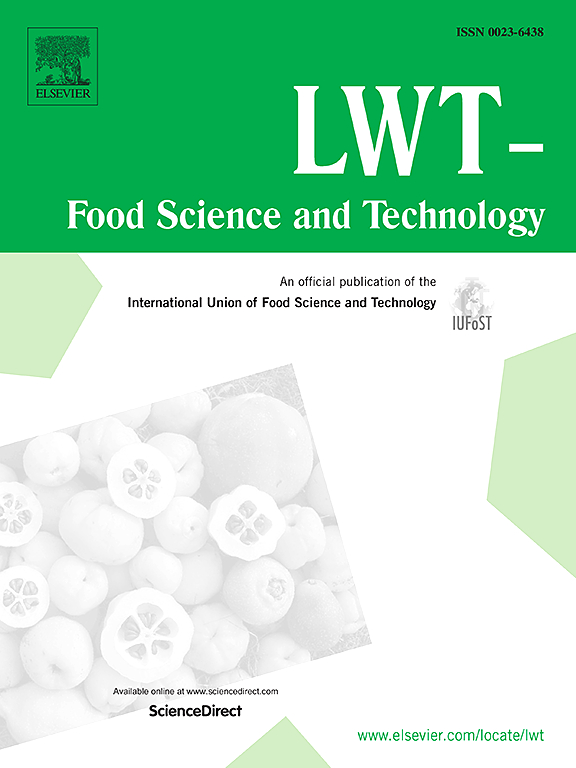核桃油微胶囊的制备及性能研究
IF 6
1区 农林科学
Q1 FOOD SCIENCE & TECHNOLOGY
引用次数: 0
摘要
本研究以微晶纤维素(MCC)和β-环糊精(β-CD)为原料,采用喷雾干燥法制备核桃油(WO)微胶囊,以减轻WO的氧化,为微胶囊的进一步应用做准备。通过扫描电镜(SEM)、傅里叶变换红外光谱仪(FTIR)和x射线衍射仪(XRD)分析,证实了WO的包封成功,包封效率(EE)为80.54%,负载能力(LC)为53.87%,WO与壁材之间存在相互作用或非共价键。该粉体的平均粒径为1553.17 nm,含水量为2.85%,溶解度为90.62%,流动性好。60℃加速试验7 d后,微胶囊的PV为4.02 meq/kg, AV为0.63 mg/g,低于核桃油的PV (5.35 meq/kg)和AV (0.81mg/g)。结果表明,该微胶囊具有良好的性能,与WO相比氧化程度降低。本文章由计算机程序翻译,如有差异,请以英文原文为准。
Preparation and properties of walnut oil microcapsules
This study uses spray drying to prepare walnut oil (WO) microcapsules with microcrystalline cellulose (MCC) and β-cyclodextrin (β-CD) to mitigate the oxidation of WO and prepare for further applications of the microcapsules. The successful encapsulation of WO was confirmed through analysis with a scanning electron microscope (SEM), fourier-transformed infrared spectrometer (FTIR), and x-ray diffraction (XRD), achieving an encapsulation efficiency (EE) of 80.54 % and a loading capacity (LC) of 53.87 %, with interactions or non-covalent bonds between WO and the wall materials. The powder has an average particle size of 1553.17 nm, 2.85 % moisture, 90.62 % solubility, and good flowability. After a 7-day accelerated test at 60 °C, the microcapsules showed a PV of 4.02 meq/kg and AV of 0.63 mg/g, lower than the walnut oil's PV of 5.35 meq/kg and AV of 0.81mg/g. The results indicate that the microcapsules have good properties and a reduced degree of oxidation compared to WO.
求助全文
通过发布文献求助,成功后即可免费获取论文全文。
去求助
来源期刊

LWT - Food Science and Technology
工程技术-食品科技
CiteScore
11.80
自引率
6.70%
发文量
1724
审稿时长
65 days
期刊介绍:
LWT - Food Science and Technology is an international journal that publishes innovative papers in the fields of food chemistry, biochemistry, microbiology, technology and nutrition. The work described should be innovative either in the approach or in the methods used. The significance of the results either for the science community or for the food industry must also be specified. Contributions written in English are welcomed in the form of review articles, short reviews, research papers, and research notes. Papers featuring animal trials and cell cultures are outside the scope of the journal and will not be considered for publication.
 求助内容:
求助内容: 应助结果提醒方式:
应助结果提醒方式:


